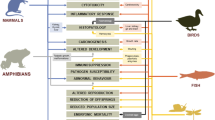Abstract
Nitroglycerine (NG) is used in manufacture of dynamite, gunpowder, and rocket propellants, and as a therapeutic agent primarily to angina pectoris. Ethylene glycol dinitrate (EGDN) is an explosive ingredient (60–80%) in dynamite along with nitroglycerine (40–20%). Both compounds are pollutants, and due to recalcitrance to biodegradation they persist in the environment. In our study we concentrated on the phytotoxicity of these compounds, looking in particular at their effects on germination, growth and development. We used mustard (Sinapis alba) seedlings, in vitro cultivated regenerants of Juncus inflexus and Phragmites australis and suspension cultures of flax (Linum usitatissimum). The flax cells absorbed NG and transformed it to both dinitroglycerine isomers. By measuring their effect on the length of primary root of white mustard seedlings we demonstrated that the toxicity of these degradation products was lower than the original compound. The phytotoxic effect of EGDN on wetland plant species is described for the first time. High concentrations of EGDN (500 mg l−1 and higher) in the medium induced wilting and browning and subsequent death of reed and rush plants.







Similar content being viewed by others
Abbreviations
- 2, 4-D:
-
Dichlorophenoxyacetic acid
- DNG:
-
Dinitroglycerine
- EGDN:
-
Ethylene glycol dinitrate
- MNG:
-
Mononitroglycerine
- NG:
-
Nitroglycerine (trinitroglycerine)
- TNT:
-
Trinitrotoluene
- TTC:
-
2, 3, 5-Triphenyltetrazolium chloride
References
Adams N, Carroll D, Madalinski K, Rock S, Wilson T, Pivetz B (2000) Introduction to phytoremediation. Report EPA/600/R-99/107. U.S.. Environmental Protection Agency, National Risk Management Research Laboratory, Cincinnati, OH
Christodoulatos C, Bhaumik S, Brodman BW (1997) Anaerobic biodegradation of nitroglycerin. Water Res 31(6):1462–1470. doi:10.1016/S0043-1354(96)00390-9
Čihalík J, Čulíková H, Dusílek P, Finfrlová P, Konrád V, Podlešáková E et al (1989) Metodický návod pro hodnocení rizikovosti tuhého průmyslového odpadu. Acta Hygien. Epidemiol Microbiol 55:38–41
Cunningham SD, Anderson TA, Schwab AP, Hsu FC (1996) Phytoremediation of soils contaminated with organic pollutants. Adv Agron 56:55–114. doi:10.1016/S0065-2113(08)60179-0
Ellis HV, Hong CB, Lee CC, Dacre JC, Glennon JP (1984) Subacute and chronic toxicity studies of trinitroglycerin in dogs, rats, and mice. Fundam Appl Toxicol 4:248–260. doi:10.1016/0272-0590(84)90126-X
French CE, Rosser SJ, Davies GJ, Nicklin S, Bruce NC (1999) Biodegradation of explosives by transgenic plants expressing pentaerythritol tetranitrate reductase. Nat Biotechnol 17:491–494. doi:10.1038/8673
Fukuchi Y (1981) Nitroglycol concentrations in blood and urine of workers engaged in dynamite production. Int Arch Occup Environ Health 48:339–346. doi:10.1007/BF00378682
Goel A, Kumar G, Payne GF, Dube SK (1997) Plant cell biodegradation of a xenobiotic nitrate ester, nitroglycerin. Nat Biotechnol 15:174–177. doi:10.1038/nbt0297-174
Hannink NK, Rosser SJ, Bruce NC (2002) Phytoremediation of explosives. Crit Rev Plant Sci 21(5):511–538. doi:10.1080/0735-260291044340
Imoto S, Kuramoto M, Iwabuchi K, Nagai H, Shimpo K (1986) Percutaneous chronic toxicity study of 10% nitroglycerin (NT-1 ointment) in rabbits. J Toxicol Sci 11(2):31–57
Johansson P, Ehrenstrom F, Ungell AL (1987) Study on Adrenergic Function after Development of Tolerance to Ethylene Glycol Dinitrate (EGDN) in Rats. Pharmacol Toxicol 61(3):172–181
Kanerva L, Laine R, Jolanki R, Tarvainen K, Estlander T, Helander I (1991) Occupational allergic contact dermatitis caused by nitroglycerin. Contact Derm 24:356–362. doi:10.1111/j.1600-0536.1991.tb01750.x
Lamm SH, Grumski KS, Fethers RF (1993) Short-term exposures to ethylene glycol dinitrate concentrations greater than 0.4 mg/m3 show no evidence of nitrate-induced headaches. Am J Epidemiol 138:653
Lowry BP, Bradfield JF, Carroll RG, Brewer K, Meggs WJ (2001) A controlled trial of topical nitroglycerin in a New Zealand white rabbit model of brown recluse spider envenomation. Ann Emerg Med 37(2):161–165. doi:10.1067/mem.2001.113031
Marshall SJ, White GF (2001) Complete denitration of nitroglycerin by bacteria isolated from a washwater soakaway. Appl Environ Microbiol 67(6):2622–2626. doi:10.1128/AEM.67.6.2622-2626.2001
Miller WE, Peterson SA, Greene JC, Callahan CA (1985) Comparative toxicology of laboratory organisms for assessing hazardous waste sites. J Environ Qual 14:569–574
Murashige T, Skoog F (1962) A revised medium for rapid growth and bio assays with tobacco tissue cultures. Physiol Plant 15:473–497. doi:10.1111/j.1399-3054.1962.tb08052.x
Pivetz BE (2001) Ground water issue: phytoremediation of contaminated soil and ground water at hazardous waste sites. EPA/540/S-01/500, pp 1–36. http://oaspub.epa.gov/eims/direntrpt.report?p_deid=23491&p_chk=65104
Sangwan RS, Gorenflot R (1975) In vitro culture of Phragmites tissue. Callus formation, organ differentation and cell suspension culture. Z Pflanzenphysiol 75:256–269
Santoro A, Rovati LC, Setnikar I (2001) Assessment of skin safety of a new glyceryl trinitrate transdermal patch. Arzneimittelforschung 51:29–37
Schnoor JL, Licht LA, McCutcheon SC, Wolfe NL, Carreira LH (1995) Phytoremediation of organic and nutrient contaminants. Environ Sci Technol 29:318A–323A. doi:doi:10.1021/es00007a002
Stayner LT, Dannenberg AL, Thun M, Reeve G, Bloom TF, Boeniger M et al (1992) Cardiovascular mortality among munitions workers exposed to nitroglycerin and dinitrotoluene. Scand J Work Environ Health 18:34–43
Tai T, Tsuruta H (1997) The effects of nitroglycol on rat isolated cardiac muscle. Ind Health 35:515–518. doi:10.2486/indhealth.35.515
Vaněk T, Nepovím A, Podlipná R, Zeman S, Vágner M (2003) Phytoremediation of selected explosives. Water Air Soil Pollut 3:259–267
Ye J, Singh A, Ward OP (2004) Biodegradation of nitroaromatics and other nitrogen-containing xenobiotics. World J Microbiol Biotechnol 20:117–135. doi:10.1023/B:WIBI.0000021720.03712.12
Zalta AH, Karlin KM, Zimmerman TJ (1985) The effect of nitroglycerin ointment on the external ocular structures of rabbits. J Ocul Pharmacol 1(1):71–77
Acknowledgements
This work was supported by projects MPO FT-TA3/118 and MYES 1MO6030
Author information
Authors and Affiliations
Corresponding author
Rights and permissions
About this article
Cite this article
Podlipná, R., Fialová, Z. & Vaněk, T. Toxic effect of nitroesters on plant tissue cultures. Plant Cell Tiss Organ Cult 94, 305–311 (2008). https://doi.org/10.1007/s11240-008-9407-8
Received:
Accepted:
Published:
Issue Date:
DOI: https://doi.org/10.1007/s11240-008-9407-8




